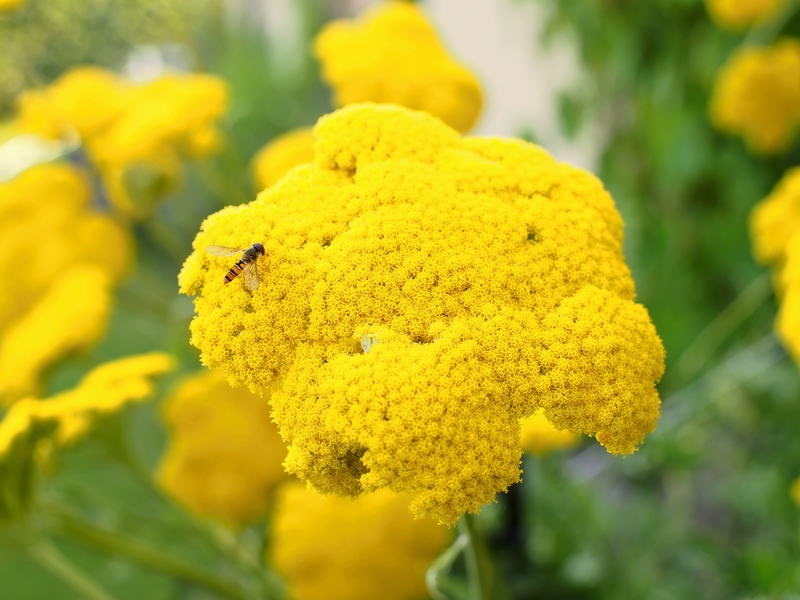Unleash Creativity with Hedge Trimming Techniques
Posted on 28/05/2025
Unleash Creativity with Hedge Trimming Techniques
Are you ready to transform your garden or landscape into a verdant canvas? Hedge trimming techniques are not just about pruning plants, but about expressing your artistic flair and shaping the natural world in unique ways. In this comprehensive guide, we'll explore how you can unleash creativity with hedge trimming, tap into innovative landscaping ideas, and master techniques to make your green spaces truly extraordinary.

Why Creative Hedge Trimming Matters
Hedges play a significant role in shaping gardens, defining spaces, and creating a sense of harmony. But why settle for simple, rectangular shapes? Through creative hedge trimming methods, you can add character, privacy, and beauty to your landscape, all while showcasing your personal touch. Below are a few reasons why you should take your hedge shaping expertise to the next level:
- Aesthetic Appeal: Artistic hedge designs make a bold visual statement.
- Personal Expression: Showcase your unique taste through living sculptures.
- Increased Property Value: Exceptional landscaping can boost curb appeal.
- Biodiversity: Varied shapes and structures attract beneficial wildlife.
- Garden Structure: Hedges serve as functional and beautiful screens, partitions, or focal points.
Understanding the Basics of Hedge Trimming
Before exploring advanced techniques, it's essential to learn the fundamentals of hedge cutting and shaping. Applying the right methods ensures healthy growth and an optimal result, providing the best foundation for creative experimentation.
When to Trim Your Hedges
Most hedges benefit from regular maintenance, usually once or twice a year. Deciduous hedges (those that lose their leaves seasonally) are best trimmed in late spring or early summer, while evergreen hedges can often be shaped throughout the growing season.
Essential Tools for Hedge Trimming
- Hedge shears: Manual for detail work; electric or petrol for large, dense bushes.
- Secateurs: For precision pruning and cutting thick branches.
- Loppers: Handling tougher, woody stems.
- Gloves and safety goggles: Protect your hands and eyes from debris and thorns.
- Strings and stakes: For marking straight lines or patterns.
Regularly sharpen and clean your tools to ensure clean cuts and avoid spreading disease.
Innovative Hedge Trimming Techniques to Ignite Your Imagination
Let's delve into the exciting world of creative hedge trimming. Whether you prefer classic forms or avant-garde shapes, these techniques will inspire you to bring out the best in your garden.
1. Topiary: The Art of Hedge Sculpting
Topiary is the time-honored craft of shaping hedges and shrubs into artistic forms, from geometric shapes to animals and whimsical figures. This technique highlights the incredible versatility of living plants.
- Start with robust, dense species like boxwood or yew.
- Use wire frames as guides for intricate shapes.
- Trim gradually and regularly for detailed forms.
2. Curved and Organic Lines
While straight edges provide structure, introducing wavy, serpentine or undulating lines can soften the landscape and add visual movement. Consider creating:
- Flowing, cloud-like mounds for a natural aesthetic.
- Meandering hedges that lead the eye through the garden.
- Asymmetrical curves for a contemporary design.
3. Textured and Layered Effects
Textural trimming involves varying the length and depth of your cuts to produce visual and tactile interest. Try:
- Alternating heights and widths for a tiered look.
- Mixing different species for contrasting leaf color and shape.
- Leaving sections longer to mimic wild growth patterns.
4. Living Fences and Sculptural Screens
Trade boring boundaries for living works of art. A hedging screen trimmed into latticework or repeating patterns (such as waves or zig-zags) provides privacy and a unique backdrop for flower beds.
5. Hedge Mazes and Labyrinths
Channel your inner landscape designer by creating intricate paths or mazes from hedges. Not only are these hedge masterpieces fun for both kids and adults, but they also become a captivating focal point in any landscape.
The Best Plants for Creative Hedge Trimming
Not all plants respond equally well to training and pruning. The following species are renowned for their tolerance of frequent trimming and suitability for intricate shapes:
- Boxwood (Buxus sempervirens): Small leaves and slow growth make it ideal for topiary and formal shapes.
- Yew (Taxus baccata): Dense evergreen needles and resilience to heavy pruning.
- Privet (Ligustrum spp.): Rapid growth for quick results, though it requires more maintenance.
- Holly (Ilex spp.): Glossy leaves and striking berries can create festive displays.
- Lonicera nitida: Fine texture, easily shaped into waves or spirals.
Planning and Designing Your Creative Hedge
To maximize the impact of your hedge trimming artistry, a thoughtful approach is key. Consider the following steps when planning your project:
1. Start with a Vision
Visualize how your hedge will enhance the existing landscape. Sketch your ideas, gather inspiration from gardens, and decide on desired forms (geometric, abstract, animal shapes, etc.).
2. Assess Growing Conditions
Different species have varying sunlight, water, and soil needs. Choose varieties that will thrive in your conditions for the healthiest and most vibrant hedges.
3. Mark Outlines and Patterns Early
Use strings, stakes, and templates to lay out precise lines or shapes before cutting. This preparation ensures symmetry and accuracy, especially with complex designs.
4. Allow Time for Growth
Ambitious sculptures and elaborate screens may require years to mature. Be patient and enjoy the evolving process, making adjustments and enhancements over time.
5. Integrate with Other Landscaping Elements
Pair your hedge art with complementary flowers, ornamental grasses, or hardscape features for a cohesive and inviting garden design.
Pro Tips for Flawless Hedge Trimming
To achieve crisp shapes and healthy plants, employ these expert recommendations:
- Trim from the bottom up to avoid crushing lower branches as you move upward.
- Keep hedge bases wider than the tops for optimal sunlight penetration and vigorous growth.
- Cut small amounts frequently rather than large sections at long intervals. This promotes density and precision.
- Sharpen tools regularly to make clean cuts and reduce disease risk.
- Step back often to check your progress from multiple angles.
- Time heavy prunings to avoid the hottest or coldest months, preventing plant stress.
Common Mistakes to Avoid in Creative Hedge Trimming
Even experienced gardeners occasionally encounter pitfalls. Watch out for these common errors to ensure your hedge designs flourish:
- Over-pruning: Removing too much foliage at once can weaken plants and lead to sparse growth.
- Neglecting shape maintenance: Artistic designs require regular touch-ups to preserve their appearance.
- Ignoring plant health: Look out for pests, diseases, and nutrient deficiencies that compromise vigor and form.
- Uneven cutting: Using guides and stepping back to check your work helps maintain consistent lines and symmetry.
Innovative Hedge Trimming Ideas to Inspire You
Ready to put your creativity to the test? Here are some distinctive hedge design concepts to spark your imagination:
- Green arches and tunnels: Shape hedges into garden entrances or walkways that invite exploration.
- Animal or character sculptures: Delight children and visitors with dragons, birds, or whimsical figures.
- Seasonal shapes: Prune hedges into stars, hearts, or bells for holidays and special occasions.
- Lettering and numbers: Showcase initials, house numbers, or inspirational words in living greenery.
- Modern geometric panels: Combine cubes, spheres, or pyramids for a contemporary effect.
Maintaining Your Creative Hedges
For your hedge artistry to last, regular maintenance is essential. Follow these best practices to keep your designs sharp and healthy:
- Water consistently, especially after heavy trimming, to promote recovery and new growth.
- Mulch around the base to retain soil moisture and suppress weeds.
- Inspect frequently for signs of pests or disease, tackling problems early.
- Feed your hedge with balanced fertilizer during the growing season for lush foliage and robust growth.
- Touch up edges regularly to maintain crisp lines, even as new shoots appear.
Embrace Your Inner Hedge Artist
Creative hedge trimming offers endless opportunities to unleash your imagination and personalize your outdoor space. Whether you're content with elegant topiary, daring animal figures, or flowing organic forms, each trimming session is a chance to nurture both your plants and your creativity.
Final Thoughts on Creative Hedge Shaping
The art of hedge trimming is no longer just a task on your gardening checklist; it's an engaging, rewarding hobby that celebrates the beauty of nature and the power of human creativity. With a mix of vision, basic horticultural knowledge, and the right hedge cutting techniques, your garden will evolve into a living masterpiece.

Frequently Asked Questions about Creative Hedge Trimming
What is the best time of year to try artistic hedge trimming?
Late spring to early summer is generally best for most species, as new growth recovers quickly. Avoid trimming during droughts or frosty periods to minimize plant stress.
How often should I shape my hedges?
Maintenance trims can be done every 6-8 weeks during the growing season. Detailed topiaries may require more frequent touch-ups.
Can I create shapes with any hedge?
While most hedges can be shaped, slow-growing, dense-foliaged species like boxwood and yew are ideal for intricate designs and precision cutting.
Are there sustainable or eco-friendly practices for creative hedge trimming?
Absolutely! Use manual shears for low-emission maintenance, compost clippings, and retain some looser sections or flowering plantings to support local pollinators and wildlife.
Conclusion: Start Your Hedge Trimming Journey Today
Now that you're equipped with the knowledge and inspiration to unleash creativity with hedge trimming techniques, it's time to get outdoors, pick up your shears, and turn your hedge into a statement of artistry. With patience, care, and imagination, your garden will become a testament to the limitless possibilities of living design. Happy sculpting!

